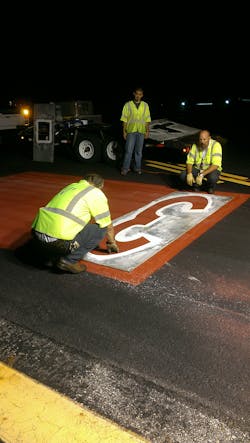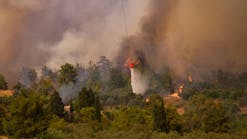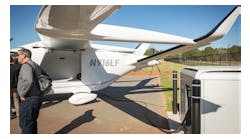Michael Reisman, deputy executive director, development and operations for the Asheville Regional Airport (AVL) in Asheville, North Carolina, said as a single runway airport, it’s limited from doing a lot of maintenance work during normal business hours during the daytime. Commercial air services starts at 5:30 a.m. daily and goes until 11 p.m., so there’s only a five to six hour window for crews to perform maintenance work.
He said AVL’s maintenance program is centered around an aggressive Part 139 inspection program. While airport operations staff is primarily tasked with performing the maintenance work, all staff are trained in Part 139 inspection to monitor the overall condition of the runway.
“We rotate our public safety staff into that inspection program as well,” he said. “There are certain days and certain times when the majority of inspections are being done by our ops staff but then we’ve also got certain days and times where our public safety staff is out there doing that as well. What the does is it helps ensure that we have as many additional sets of eyes on the airfield as possible to identify things because it’s easy for the same people to get tunnel vision and easily start overlooking the things they’re accustomed to seeing on a regular basis.”
Get a plan in place
When preparing a maintenance plan for your runways, one of the key areas to consider is a crack sealing plan. Al Schultz, president of Sherwin Industries Inc., said a lot of airports use silicon on their concrete areas and rubberized materials on the asphalt areas.
“There’s also going to be areas of fray where you will have alligator cracking on asphalt surfaces or spalling on concrete,” he said. “A good patching product is definitely something that needs to be put into their maintenance plan. And something that’s FOD-free, that won’t break apart and create FOD.”
Schultz said people do crack seal year-round, but it’s not going to be the best in winter. Performing the process in the summer months improves the performance of the material. Clean and dry is extremely important when doing any surface crack sealing or silicone work.
“You can get it clean and dry in the winter, but the cracks tend to be more wide-open in the wintertime,” he said. “When you fill them up, when they close down in the spring that can create like a bump in the crack sealant or the silicone.”
While the process itself remains an “old school” practice for crack repairs, Schultz said the sealing equipment has greatly improved in recent years that allow for heavier capacities and improved melt rate.
AVL has an annual crack seal program in place. Reisman said it’s one of the most important pavement maintenance functions the airport can carry out in order to preserve the longevity of the pavement. The airport used to contract with outside vendors to perform the work, but as cracks became more prevalent with the age of the runway, AVL was able to purchase equipment to perform the work in-house about three years ago, in part from a grant from the North Carolina Department of Transportation Division of Aviation.
“The cost of the equipment essentially pays for itself by the second time we used it,” he said.
The airport also has in-house resources for performing striping work. Reisman said they can’t restripe an entire runway, but the equipment allows staff to do touchup work on the airfield.
But before an airport even starts to create a maintenance plan for the airfield this coming season, Schultz said it’s important to get out there and do a full assessment of the area and the current condition of your runways, taxiways and aprons.
“Finding out what you have has got to be first on the list,” he said. “What are your problem areas, what needs to be addressed first, what can hold off for a week or a year even; and what needs to be done now.”
Schultz said commercial airports should give extra consideration to markings and FOD removal.
AVL owns and operates a vacuum sweeping device to clean the airfield as well. Reisman said the airport put a plan in place where the airport is broken up into quadrants and priority areas so the sweeper hits those areas on a regular basis.
Preformed thermal plastic markings continue to take the place of a lot of the painted markings on taxiways at airports. While the plastic will last seven to 10 times longer than paint in those areas, Schultz said airports need to consider cost and regular maintenance of the airfield when determining if the product would be a good fit for your facility.
“A thing to consider is where your location is. What kinds of plows are you using to clear your runways and taxiways,” he said. “This product is susceptible to plow damage, so somebody in Dallas doesn’t really have to worry about that aspect of their plan but somebody in Milwaukee most definitely has to.”
AVL is rebuilding almost its entire airfield, which includes construction of a new runway and installation of new lighting.
Reisman said all of the lighting and guidance equipment will be brand-new. Because of that, all of the lighting will be rotated on a quarterly basis. A certain number of bulbs will be rotated out of their airfield and put back into inventory with new bulbs replacing them so over the course of the first two years of the operational runway so the airport doesn’t find itself replace a large amount of bulbs at one time.
“I’ve personally had the experience of commissioning a runway and taxiway in my prior airport manager lives and the one thing that we discovered is that runway light fixtures and light bulbs, regardless of whether they’re LED, quartz or incandescent or otherwise, all have a finite life,” he said. They’re all designed and built with the expectation that their lives will only last a certain number of operational hours.
“If you don’t pay attention what happen is they all start burning out about the same time when they all start to reach the end of their useful life. As such for a small airport, if you have to start replacing a large quantity of bulbs all at once and you didn’t necessarily plan or budget for it, you find yourself with a little bit of a budgetary conundrum in terms of having to spend large sums of money to replace large volumes of lightbulbs and then you’re standing there scratching your head wondering why everything is buring out at one time and you’re starting to question whether you have some kind of an electrical or voltage problem on the airfield.”
Keep an eye on FOD
While the surface of the runway and taxiway is very important to airport operations, it’s also important to make proper plans to clear them of anything that isn’t supposed to be there.
Scott Aukerman, field services supervisor for the Denton Enterprise Airport in Denton, Texas, said his facility is very cognizant of FOD issues to make sure the runways are safe for the flying public.
The seventh busiest airport in Texas, Denton has a 7,000 foot long runway with more than 140,000 operations per year at the facility meaning Aukerman and his crew need to keep on top of FOD issues throughout the day.
“We start our day out every morning doing a visual inspection of our airfield and taxiways,” he said. “We pick everything up from stones to anything that falls off the plane like screws.”
Aukerman said the airports sweeps the runway starting at 3 a.m. each day in order to avoid the challenges with air traffic. They use a 16-foot FOD Boss pulled behind a Kubota at about 20 miles per hour. Using a double-gang FOD Boss, the sweeping can be completed in three hours, covering 30 miles of surface. The runway is cleared in 10 passes.
The airport used to use a regular street sweeper to clear the runway and taxiways, but Aukerman said they discovered that had left FOD of its own when in operations because the sweeper used metal bristled brushes.
In the event of an incident with an aircraft on the runway, such as a flat tire or belly landing, he said staff also does a spot sweep or runway sweep to make sure there isn’t any debris left from the plane.
He said people in the tower also are on the lookout throughout the day for FOD and alerts staff to any issues they may find.
“Many times traffic is held up if there’s FOD on the runway because it’s not safe, so we have to address it immediately” he said.
Denton has to pay extra attention to FOD issues because Aukerman said some tenants do work on military planes, which demands an extra level of cleanliness.
FOD is collected and shared with tenants and contactors during regular safety meetings, he said, to educate them about the challenges staff has in clearing the runway and to make them all aware of the debris they may be adding to the FOD issues.
“You have contactors that come in and subconsciously, things get away from them and with high winds, a lot of stuff turns into FOD by accident,” he said. “It’s just something that we do keep people aware of.”
This also means keeping an eye on what’s happening on the landside of the airport. Aukerman said they include a FOD inspection on the landside as well.
“Again, if it’s on the ground, if it’s on one side of the fence, there’s a good chance it’s going to pick up and be on my airfield,” he said.




